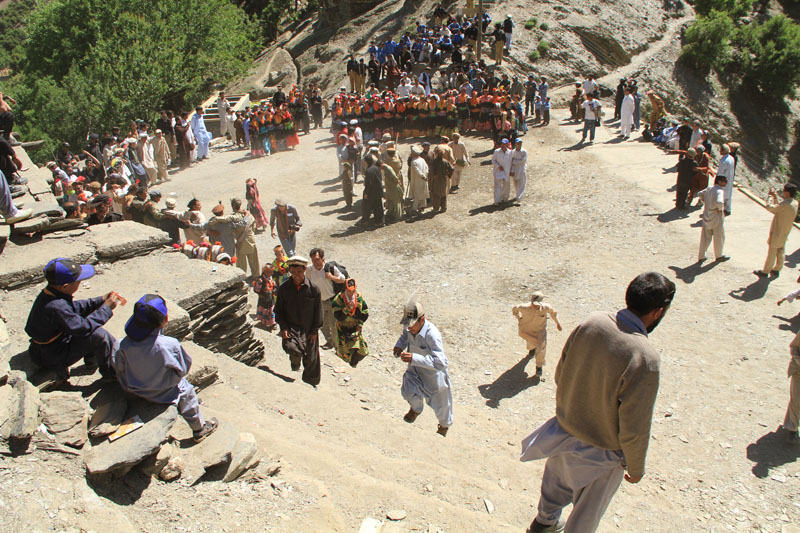Click on images to enlarge
A bulletin board caught my attention while I was roaming in the narrow streets of Peshawar: “Celebrate Kalash Festival with the KPK Tourism”. The message was so appealing that it went through my mind all day.
I grew up watching documentaries on TV regarding these ancient nomadic people who call themselves “Kalash” and follow a distinct culture, living deep in the mountains of North West Pakistan. I always dreamt of visiting the place that I had read about in books and seen in postcards. “Now is the time to actually experience it,” I said that to myself and without any further delay; I booked my flight to Chitral to experience the culture that had endlessly fascinated me.
There lies a mystical valley in Hindukush known as Kafiristan, the land of infidels. Until I actually visited the place, I believed it to be a myth. I took a local van from Chitral Bazar and went through a rough three and a half hour journey via Ayun Valley that ended up in the magical valley called Kalash, an unknown land surrounded by giant mountains and rivers.
Kalash consists of 3 valleys: Rumbur, Bumboret and Birir. Rumbor is the oldest and largest, while Bumboret is the most visited, populated and developed of the three. Situated between two giant mountains, it runs along a small road with a water stream from glaciers flowing downwards.
While searching for my hotel, I came across beautiful women in black gowns decorated with colorful embroidery. When they saw me, hearty greetings of “Ishpaata” were shouted my way; the Kalasha way of saying hello.
The Kalash people are distinct in their language, way of living, culture, religion and norms and have been carrying around this culture since centuries with very little or no change over time. Unlike other parts of Khyber Pakhtunkhwa, this was the first valley where I saw unveiled women roaming around freely. It felt like I was not in northern Pakistan but some foreign nomadic village shown on the National Geographic channel.
Still practicing their ancient customs, they have a proud and almost exclusive culture. They claim to be the descendants of the armies of Alexander who were left behind from his campaign in the area although there isn’t any evidence that would suggest that he passed from this area. The physical attributes of the people usually trace back to the Greek civilization as most of the Kalash are fair skinned and have blue eyes, rosy cheeks and blonde hair.

SONY DSC
The next morning, while the valley was still under shadow with the sun behind the mountains, I woke up to drum beats. Upon looking out the window beside my bed, I saw groups of Kalasha women with their young ones walking away from the village towards the ground where the festival was being held. As if on cue, I jumped up, grabbed my camera and rushed after them.

SONY DSC

Kalasha Village - Rumbor
Before reaching the ground, I came across the real village of Kalashas next to the water stream. On the way to the ground, I saw centuries old wooden houses stacked on top of one another, rising up the hillsides where one house’s roof forms the veranda to another house above. I saw Kalasha women getting ready and washing their hair and cloths by the stream.
Photo by author Photo by author
SONY DSC
Apparently, they were all gathering at one place for family reunions. Dressed in their new clothes, the women were standing in the middle of the ground, preparing to dance while the men were encircling the area, silently reciting prayers to protect the valley from bad omens.
I also learnt that they celebrate the arrival of spring festival, also known as Chilimjust/Joshi every year in May which is dedicated to future harvests.
The festival stared with a family reunion. They danced to drum beats, the women danced in circle, their arms around one another’s waists and shoulders, spinning in groups of twos or threes and alternating with trance-like encircling lines. The men and women both also sing together to beautiful folk music.
Photo by author Photo by authorThis festival lasts at least four days and incorporates different kinds of dances and rituals throughout. Once over, the valley returns to its normal routine. A strange feeling of peace settled over me as I watched these happy people.
My stay in the valley was short-lived, yet the whole time that I was there, I had no connection with the outside world. The valley is a world in itself; it almost cajoles you into keeping away from the chaotic outside life.
The entire experience was an indulgent one. I found myself in a place unlike any other in Pakistan. The uniqueness of this culture, the practices of their religion and the strange traditions here, came as breath of fresh air.
However, it is indeed distressing that their numbers are dwindling by the day. Last year their population accounted for over 4000. A year later, only around 3500 Kalashas remain. The biggest cause of this are faith conversions.
Every day that I was there, I would wake up early, leave my hotel room and find a comfortable spot in the valley. There I would just sit in a corner and observe the ways of Kalashas.

Kalasha women passing by a narrow street in their wooden village
As I write this, somewhere in the deep recesses of my heart, I can still feel the rhythm of their dances.
The author is an adventure seeker, travel photographer and writer, who loves mountains, deep sea diving, food and tea. He tirelessly wanders around Pakistan for positive stories. He blogs at www.iexplorepakistan.com. You can view his photography here.
The views expressed by this blogger and in the following reader comments do not necessarily reflect the views and policies of the Dawn Media Group.
















































